牛津译林版(2019)选择性必修一 Unit 3 The art of painting L5 Integrated skills (II) 微课课件(15张PPT)
文档属性
| 名称 | 牛津译林版(2019)选择性必修一 Unit 3 The art of painting L5 Integrated skills (II) 微课课件(15张PPT) |

|
|
| 格式 | pptx | ||
| 文件大小 | 16.5MB | ||
| 资源类型 | 教案 | ||
| 版本资源 | 牛津译林版(2019) | ||
| 科目 | 英语 | ||
| 更新时间 | 2022-12-28 19:26:13 | ||
图片预览

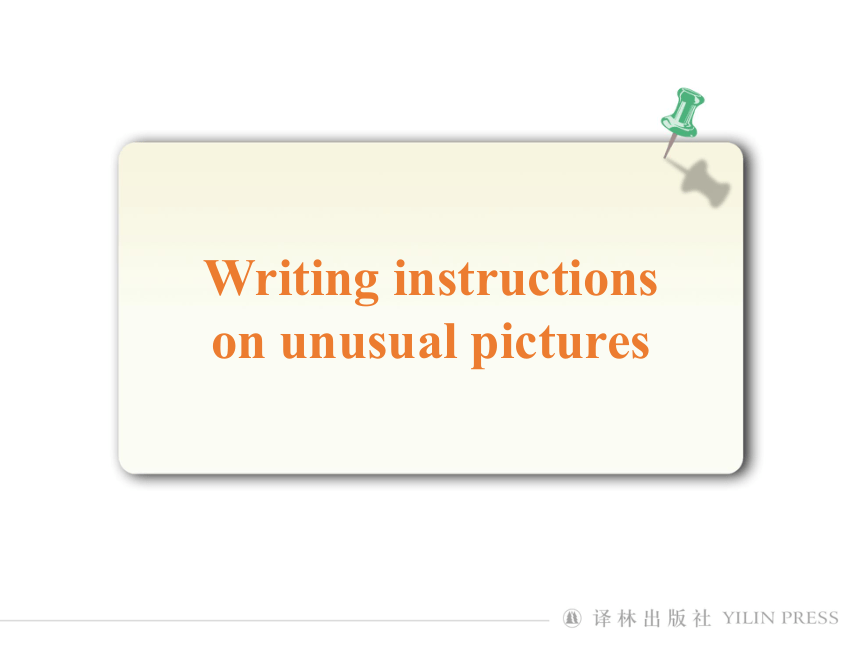
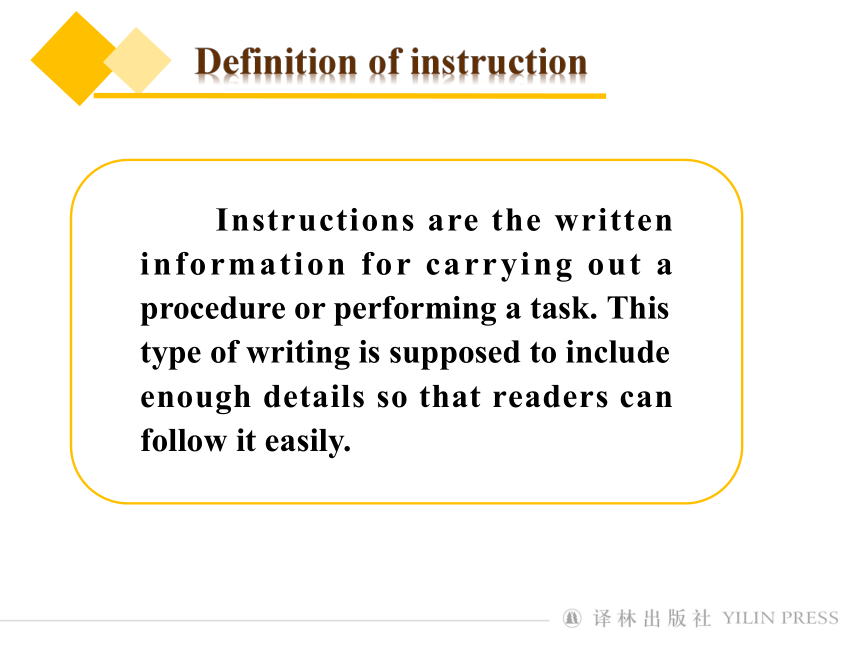
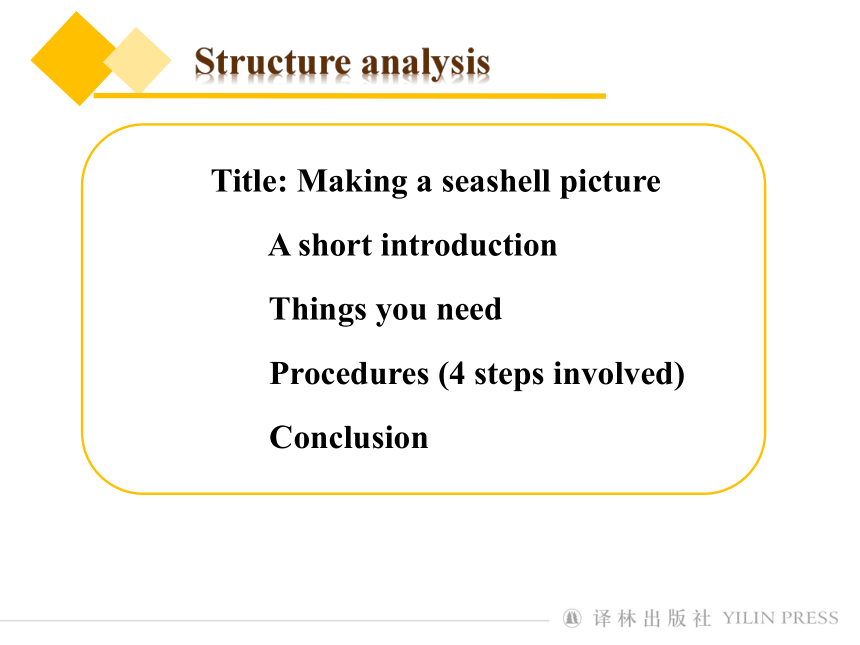
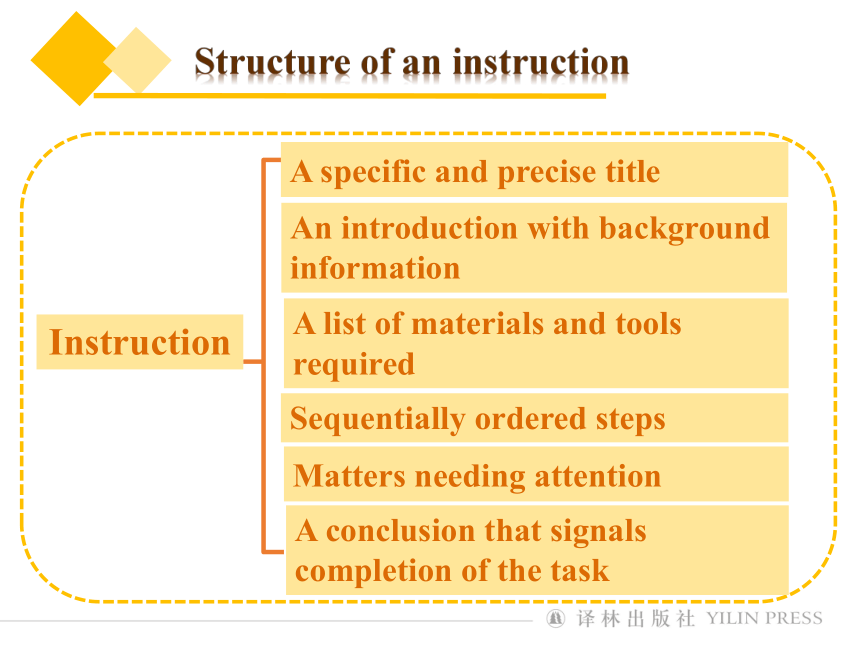
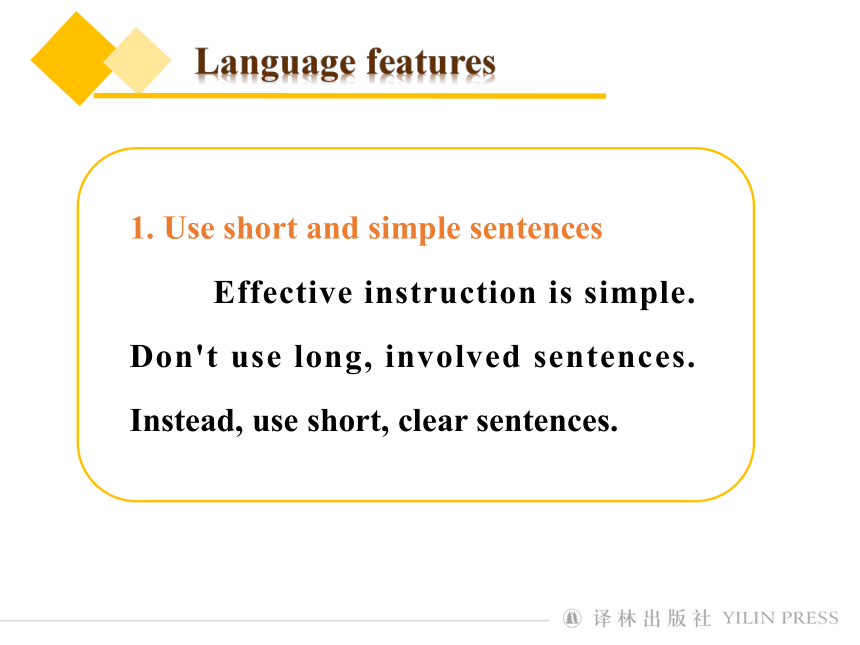
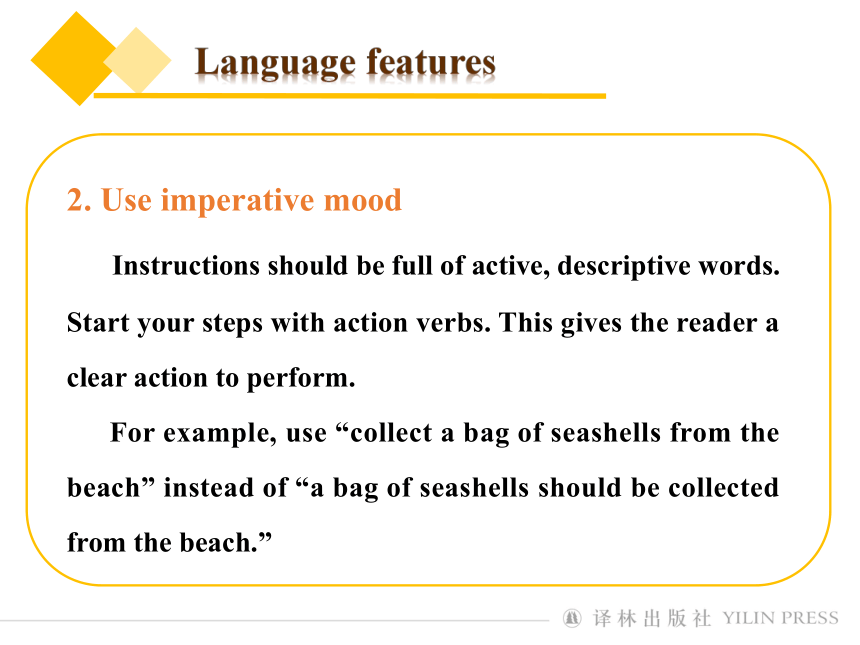
文档简介
(共15张PPT)
Unit 3 The art of painting
Integrated skills (II)
Writing instructions on unusual pictures
Instructions are the written information for carrying out a procedure or performing a task. This type of writing is supposed to include enough details so that readers can follow it easily.
Definition of instruction
Title: Making a seashell picture
A short introduction
Things you need
Procedures (4 steps involved)
Conclusion
Structure analysis
Matters needing attention
Structure of an instruction
A list of materials and tools required
Sequentially ordered steps
Instruction
A conclusion that signals completion of the task
A specific and precise title
An introduction with background information
1. Use short and simple sentences
Effective instruction is simple. Don't use long, involved sentences. Instead, use short, clear sentences.
Language features
2. Use imperative mood
Instructions should be full of active, descriptive words. Start your steps with action verbs. This gives the reader a clear action to perform.
For example, use “collect a bag of seashells from the beach” instead of “a bag of seashells should be collected from the beach.”
Language features
3. Address the reader
When writing instructions, you should address the reader. Do this by using the word “you” or “your”. This helps lead the reader personally through the steps.
Language features
4. Make your statements specific
When writing instructions, be as specific as possible. Outline exactly what readers should do. This includes what shapes and sizes of seashells to select, where to arrange the seashells and how to stick each seashell to the cardboard.
Language features
5. Use sequence and time transitions
Transitions help connect the steps to each other. They also help relate the ideas. In instructions, you will use sequence and time transitions. This helps the reader understand the step-by-step instructions.
Some common transitions are: first, next, then, finally, after, before.
Language features
6. Give an example if necessary
If you think a statement may puzzle the readers, you can give an example to illustrate. Such as “Cut the vegetables to create different parts of the face. For example, red peppers can be used to make the mouth.”
Language features
Making a string picture
String art is a fun, easy way to make a colourful picture by wrapping thread around pins or gluing string on the card. This is an inexpensive activity that can add some personality to your walls.
Things you need
Card Thin string Glue
A sample for appreciation
Procedures
Step 1: Use a crayon or pencil to draw the outline of a picture on the card. For example, an abstract pattern, a picture of things, a scene or a person.
Step 2: Spread the glue where you want to attach the string.
Step 3: Paint different parts of the string.
The best part about this art project is that you can hang it on your wall for decoration. But before you do, make sure you frame the string picture.
A sample for appreciation
There are many things that you can use to make unusual pictures, so why not have a go at it I am sure you will experience great fun.
Concluding remarks
Unit 3 The art of painting
Integrated skills (II)
Writing instructions on unusual pictures
Instructions are the written information for carrying out a procedure or performing a task. This type of writing is supposed to include enough details so that readers can follow it easily.
Definition of instruction
Title: Making a seashell picture
A short introduction
Things you need
Procedures (4 steps involved)
Conclusion
Structure analysis
Matters needing attention
Structure of an instruction
A list of materials and tools required
Sequentially ordered steps
Instruction
A conclusion that signals completion of the task
A specific and precise title
An introduction with background information
1. Use short and simple sentences
Effective instruction is simple. Don't use long, involved sentences. Instead, use short, clear sentences.
Language features
2. Use imperative mood
Instructions should be full of active, descriptive words. Start your steps with action verbs. This gives the reader a clear action to perform.
For example, use “collect a bag of seashells from the beach” instead of “a bag of seashells should be collected from the beach.”
Language features
3. Address the reader
When writing instructions, you should address the reader. Do this by using the word “you” or “your”. This helps lead the reader personally through the steps.
Language features
4. Make your statements specific
When writing instructions, be as specific as possible. Outline exactly what readers should do. This includes what shapes and sizes of seashells to select, where to arrange the seashells and how to stick each seashell to the cardboard.
Language features
5. Use sequence and time transitions
Transitions help connect the steps to each other. They also help relate the ideas. In instructions, you will use sequence and time transitions. This helps the reader understand the step-by-step instructions.
Some common transitions are: first, next, then, finally, after, before.
Language features
6. Give an example if necessary
If you think a statement may puzzle the readers, you can give an example to illustrate. Such as “Cut the vegetables to create different parts of the face. For example, red peppers can be used to make the mouth.”
Language features
Making a string picture
String art is a fun, easy way to make a colourful picture by wrapping thread around pins or gluing string on the card. This is an inexpensive activity that can add some personality to your walls.
Things you need
Card Thin string Glue
A sample for appreciation
Procedures
Step 1: Use a crayon or pencil to draw the outline of a picture on the card. For example, an abstract pattern, a picture of things, a scene or a person.
Step 2: Spread the glue where you want to attach the string.
Step 3: Paint different parts of the string.
The best part about this art project is that you can hang it on your wall for decoration. But before you do, make sure you frame the string picture.
A sample for appreciation
There are many things that you can use to make unusual pictures, so why not have a go at it I am sure you will experience great fun.
Concluding remarks
同课章节目录
- Unit 1 Food matters
- Welcome to the unit
- Reading
- Grammar and usage
- Integrated skills
- Extended reading
- Project
- Unit 2 The Universal Language
- Welcome to the unit
- Reading
- Grammar and usage
- Integrated skills
- Extended reading
- Project
- Unit 3 The art of painting
- Welcome to the unit
- Reading
- Grammar and usage
- Integrated skills
- Extended reading
- Project
- Unit 4 Exploring poetry
- Welcome to the unit
- Reading
- Grammar and usage
- Integrated skills
- Extended reading
- Project
